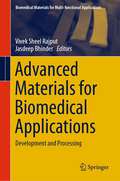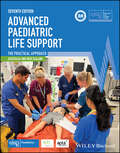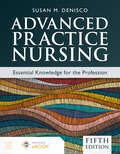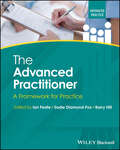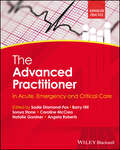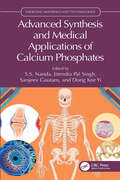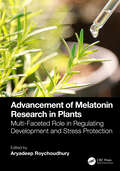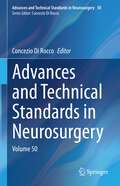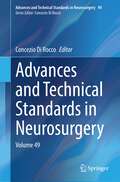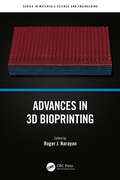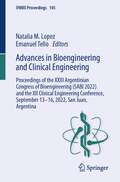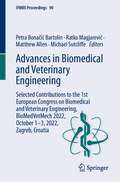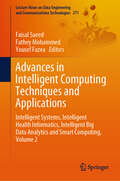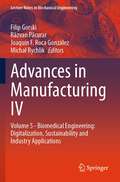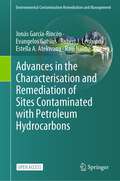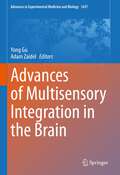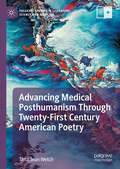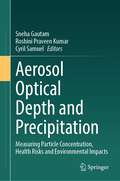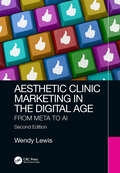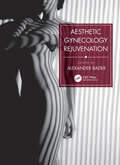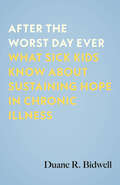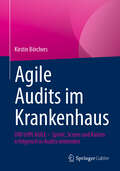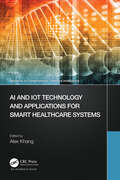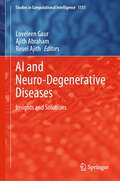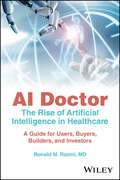- Table View
- List View
Advanced Materials for Biomedical Applications: Development and Processing (Biomedical Materials for Multi-functional Applications)
by Vivek Sheel Rajput Jasdeep BhinderThis book provides an insight into the basic fundamentals of the biomaterials used for the biomedical applications, their development and processing techniques. Advanced materials are significantly utilized for the biomedical applications ranging from dental devices to cancer treatment owing to their higher biocompatibility and better interaction with tissues. This book covers the various topics that include basic biocompatibility phenomena, insight to materials science, class of different advanced materials as a biomaterials, development and processing techniques, design and analysis of the developed advanced materials, investigation of its properties and major applications. Recent information regarding the development techniques and methods for improving the properties of the advanced materials in the field of biomedical applications is highlighted in detail. The textbook offers clear explanation of the text in the chapters with self-explanatory figures and tables. It demonstrates the novel methods, opportunities and ideas for developing biomaterials in the field of biomedical applications. It also includes critical review study of the developed advanced materials for biomedical applications in a new summarized form. The inclusion of the discussions on hybrid polymer-based composites and self-healing composite materials offers a special feature in the textbook. It features a thorough overview of the simulation aspect in the biomedical applications. The book features at least 50% of its references from last three–four years’ work in the field of biomaterials and biomedical. The book content adds to the redundancy in the literature work related to biomedical and biomaterials.This book is a valuable resource for academicians, students and scholars from science and engineering background having interest in biomaterials. It is helpful to the biomedical engineering group especially in countries or location where they don’t have access to the major journals.
Advanced Paediatric Life Support, Australia and New Zealand: The Practical Approach (Advanced Life Support Group)
by Stephanie SmithADVANCED PAEDIATRIC LIFE SUPPORT The gold standard for treating paediatric emergencies Advanced Paediatric Life Support, Australia and New Zealand: A Practical Approach to Emergencies is the internationally renowned manual on emergency paediatric care. This text reinforces the course developed by the Advanced Life Support Group and utilises their tried and tested method of treating children in the event of a life-threatening illness or injury. Adapted specifically for Australia and New Zealand, this edition is a trusted resource used by qualified medical professionals dealing with emergencies involving paediatric patients. With a clear layout and straightforward style, this text can be used as a functional tool both for training and in the event of an emergency. In this seventh edition you will find descriptions of both common and uncommon paediatric emergencies which may be encountered in clinical practice, along with their causes, and how to best treat them during the first hours after presentation. This text offers an evidence-based approach to its subject, which includes: The latest Australia and New Zealand Resuscitation Councils (ANZCOR) guidelines A thorough introduction to the structured approach to paediatric emergencies, including important non-technical skills and communication Comprehensive explorations of the seriously ill child, including airway and breathing, circulation, decreased consciousness, seizures and exposure Practical discussions of the seriously injured child, including examinations of chest, abdominal, brain and spinal injuries Evidence-based life support treatment and the practical application of the Advanced Paediatric Life Support structured management Perfect for emergency care physicians, nurses and other allied health professionals, Advanced Paediatric Life Support, Australia and New Zealand: A Practical Approach to Emergencies will also benefit paediatric clinicians, doctors-in-training and anyone else with an interest in the team management and treatment of paediatric emergencies. Advanced Life Support Group (ALSG) is a Manchester, UK, -based charitable organisation whose medical education and training programmes improve outcomes for people in life-threatening situations, anywhere along the health care pathway, anywhere in the world. As a charity, ALSG invests all profits in educational resources and partners with the most effective and respected organisations worldwide to develop exceptionally high-quality programmes.
Advanced Practice Nursing: Essential Knowledge for the Profession
by Susan M. DeNiscoAdvanced Practice Nursing: Essential Knowledge for the Profession, Fifth Edition is a core advanced practice text used in both Master's Level and DNP programs. Along with original chapters, this bestselling text is a thoughtfully crafted compilation of existing chapters from a variety of advanced practice nursing textbooks from Jones & Bartlett Learning. The strength of this approach is that each chapter was written by experts in each of the content areas, creating a comprehensive and well-rounded resource for the advanced practice nursing student. The Fifth Edition is framed around the new Domains from the AACN Essentials for advanced practice education as well as the Essentials for Doctoral Education featuring the most up-to-date content on each set of Essentials. Thoroughly updated, the authors address current and emerging trends, including emergency preparedness, financing health care, the impact of big data on healthcare outcomes, ethical leadership, and more timely topics.
The Advanced Practitioner: A Framework for Practice (Advanced Clinical Practice)
by Ian Peate Sadie Diamond-Fox Barry HillThe Advanced Practitioner An essential text for Advanced Practitioners In The Advanced Practitioner: A Framework for Practice, a team of distinguished Advanced Practitioners (APs) and academics deliver the go-to text for trainee APs, with a strong focus on the four pillars that underpin advanced practice: clinical practice, education, research, and leadership. The patient is at the core of this essential resource, which offers the knowledge required to care safely for people in a variety of care settings, as well as with a range of common and specialised holistic interventions. Readers will also find: A thorough introduction to the core principles of advanced practice, including the AP curriculum and the principles of physiology, pharmacology, and pathophysiology Comprehensive exploration of the clinical pillar, including discussions of clinical history taking and physical examination Practical discussion of the education and research pillars, including an exploration of research principles and education and learning Discussion of innovation in practice, the leadership pillar, and how to deal with difficult situations Perfect for trainee advanced practitioners, The Advanced Practitioner: A Framework for Practice will also benefit healthcare students and trainee medical associate professionals.
The Advanced Practitioner in Acute, Emergency and Critical Care (Advanced Clinical Practice)
by Ian PeateThe Advanced Practitioner in Acute, Emergency and Critical Care Dedicated text for trainee and newly-qualified Advanced Practitioners specialising in acute, emergency and critical care Aligned with the Nursing and Midwifery Council (NMC) and the Health and Care Professions Council (HCPC) regulatory body requirements, this formative text is the first of its kind, covering a variety of key topics for advanced practitioners working in acute, emergency and critical care. Written by experienced advanced practitioners and academics closely involved in the delivery of both the clinical and academic components of advanced practice training programmes, The Advanced Practitioner in Acute, Emergency and Critical Care presents: Complex decision making, covering legal and ethical frameworks (including patient safety), communication skills and breaking bad news, and end of life care Diagnosis and management of patients, covering radiology, principles of point of care ultrasound (PoCUS), laboratory tests and prescribing Resuscitation and first stage management of the critically unwell, advanced resuscitation skills, shock, intra- and inter-hospital transfers, and organ donation History taking, physical examination, and consultation models Learning support with accreditation considerations boxes, clinical investigations, examination scenarios, pharmacology boxes, pathological and psychological considerations, social and cultural considerations, case studies, self-assessment questions, and more Utilising a multi-professional and inclusive framework of advanced level practice, this is an essential resource for all trainee and newly-qualified advanced practitioners. The text also serves as an excellent classroom aid for lecturers teaching advanced practice courses.
Advanced Synthesis and Medical Applications of Calcium Phosphates (Emerging Materials and Technologies)
by S. S. Nanda Jitendra Pal Singh Sanjeev Gautam Dong Kee YiCalcium phosphate materials are used in many medical and dental applications. Advanced Synthesis and Medical Applications of Calcium Phosphates covers the structure, chemistry, synthesis, and properties of both natural and synthetic calcium-based biomaterials and details a variety of medical applications. Depicts the latest advances in using calcium phosphates in bone regeneration and tissue engineering Includes the latest generation of regenerative biomaterials with an integrated perspective combining both research and clinical issues Provides an understanding of the clinical targets and requirements for regenerative medicine Detailing fundamentals through applications, this book helps biomaterials researchers to better understand the clinical targets and requirements for use of these materials for optimal synthesis and development.
Advancement of Melatonin Research in Plants: Multi-Faceted Role in Regulating Development and Stress Protection
by Aryadeep RoychoudhuryMelatonin (N-acetyl-5-methoxytryptamine) is a widely studied biomolecule, and its function has been investigated in bacteria, mammals, birds, amphibians, reptiles, fish and plants. Melatonin research in plants the last five years has attained an exponential growth phase and the number of publications related to phytomelatonin has significantly increased in present times. All this research is directed towards establishing multifarious roles of melatonin in plants, including the promotion of seed germination and seedling growth, influencing plant development and senescence, alteration of flowering and fruiting time and grain yield, modulating circadian rhythms, improving resistance against biotic stress as well as tolerance to abiotic stress, reducing oxidative stress, and stimulating plant immune response. However, to date, an exhaustive book, solely and exclusively dedicated to melatonin research on various aspects of plant biology, has not been published by any renowned publisher or is available in the market. Keeping all these facts in mind, this book aims to compile the most recent developments in the arena of melatonin-mediated regulation of plant physiology under optimal and sub-optimal conditions. This book will initiate and introduce the readers to the state-of-the-art developments and trends in this field of study and will largely cater to the scientific need of scientists engaged in melatonin research across the globe. The book will be unique of its kind and will draw the attention of scientific and research communities engaged in the field of melatonin research.The key features of this book: Authors will address the topics which would provide advances in the understanding of diverse functions of melatonin in plants, encompassing almost all the aspects that have been investigated so far Integrate the overall mechanistic function of melatonin, genomics and proteomics tools, and genetic engineering to manipulate endogenous melatonin levels, thus giving a holistic view of plant-level studies under normal or challenging situations Largely help the readers to design future research programs in exploiting melatonin as a protective agent to develop climate-resilient and pathogen-resistant plants Benefit the crop protection program and ensure food security Chapters will be supplemented with ample illustrations and figures This book will be beneficial to research scholars and Ph.D. students involved in melatonin research and working on stress physiology, stress proteins, genomics, proteomics and genetic engineering in different universities and research institutes all over the world. The book can also be used as an advanced reference book for the coursework of research and master’s level students. It will be of use to people involved in improving plant growth and yield, as well as the performance of plant species in the face of climate change and pathogen infection, using melatonin as the prime protective agent and signaling molecule. Although the book will directly benefit the academic and scientific community, it will also indirectly draw the attention of industries or companies that manufacture or sell chemical products, since the book will highlight in detail the antioxidative potential of melatonin. This will create impetus at the industrial level for the isolation and synthesis of melatonin as a beneficial chemical agent. Applying melatonin as an ameliorating agent against different stresses at the field level will also increase the demand for this chemical among the farmers and will promote large-scale sales and utilization of melatonin for ensuring crop protection and increasing yield.
Advances and Technical Standards in Neurosurgery: Volume 50 (Advances and Technical Standards in Neurosurgery #50)
by Concezio Di RoccoIn this book, internationally recognised experts provide an update on some important basic and technical aspects of neurosurgery. Intracranial tumours are the main focus of the book with chapters dealing with ependymomas, a tumour that still offers difficulties of interpretation in terms of both pathological features and management modalities, intraventricular tumours, which require particular attention in the choice of treatment modalities, and tumours considered typically paediatric that may still present in adulthood although with different aspects. Technical approaches to difficult anatomical areas are discussed in three chapters, dealing with the orbit, the craniocervical junction and the brainstem, respectively. Two rather didactic chapters, dealing with the minimally invasive technique for the spine and the clipping of cerebral aneurysms, are intended to contribute to the training of young neurosurgeons by illustrating the surgical steps in detail. The contribution of ultrasound to neurosurgery is illustrated in two chapters that should arouse great interest. The so-called Chiari malformations is approached in a chapter emphasising the role of cranio-cerebral disproportion in their pathogenesis. Finally, a chapter devoted to the ethical attitude that should characterise the daily practice of the neurosurgeon completes the book.Like the previous volumes in the series, this one represents an important contribution to the advancement of neurosurgical specialities.
Advances and Technical Standards in Neurosurgery: Volume 49 (Advances and Technical Standards in Neurosurgery #49)
by Concezio Di RoccoThe book offers the update on several basic and clinical problems in neurosurgery compiled by internationally recognized experts. The main topics covered are cerebral tumors, epilepsy and vascular malformations, congenital and acquired spine anomalies.The first chapter is devoted to the genetic of the Moya-Moya disease, a cerebral vascular disease quite common in Asia that is not yet sufficiently known. The second chapter is devoted to the current application of VR/AR (virtual reality/augmented reality) to pediatric neurosurgery. The next four chapters discuss the management of spine diseases, respectively the tethered cord syndrome , the severe forms of spondylolisthesis, the role of perioperative checklists, and the long-term outcomes of myelomeningocele. Two chapters deal with the surgical aspects of the management of intraventricular tumors. Cerebral tumors, namely malignant gliomas and jugular foramen tumors are the subject of the remaining chapters.Approaching the issue of technical standards in the everyday clinical practice of neurosurgery, this book of great interest for neurosurgeons, neuroradiologists, vascular and plastic surgeons.
Advances in 3D Bioprinting (Series in Materials Science and Engineering)
by Roger J. Narayan"3D bioprinting" refers to processes in which an additive manufacturing approach is used to create devices for medical applications. This volume considers exciting applications for 3D bioprinting, including its use in manufacturing artificial tissues, surgical models, and orthopedic implants.The book includes chapters from leaders in the field on 3D bioprinting of tissues and organs, biomedical applications of digital light processing, biomedical applications of nozzle-free pyro-electrohydrodynamic jet printing of buffer-free bioinks, additive manufacturing of surgical models, dental crowns, and orthopedic implants, 3D bioprinting of dry electrodes, and 3D bioprinting for regenerative medicine and disease modeling of the ocular surface.This is an accessible reference for students and researchers on current 3D bioprinting technology, providing helpful information on the important applications of this technology. It will be a useful resource to students, researchers, and practitioners in the rapidly growing global 3D bioprinting community.
Advances in Bioengineering and Clinical Engineering: Proceedings of the XXIII Argentinian Congress of Bioengineering (SABI 2022) and the XII Clinical Engineering Conference, September 13–16, 2022, San Juan, Argentina (IFMBE Proceedings #105)
by Natalia M. Lopez Emanuel TelloThis book offers a timely snapshot of research, technologies and best practices in the broad area of bioengineering and clinical engineering. Contributions report on advances in biomechanics, biomaterials, and tissue engineering, biosensors and instrumentation, biomedical signal processing, and rehabilitation engineering. Further, it covers topics relating to quality engineering and management of health services, and of engineering education. The book gathers selected, peer-reviewed contributions to the XXIII Argentinian Congress of Bioengineering and the XII Clinical Engineering Conference, both known under the acronym “SABI 2022”, held on September 13–16, 2022, in San Juan, Argentina, and organized by the Sociedad Argentina de Bioingeniería.
Advances in Biomedical and Veterinary Engineering: Selected Contributions to the 1st European Congress on Biomedical and Veterinary Engineering, BioMedVetMech 2022, October 1–3, 2022, Zagreb, Croatia (IFMBE Proceedings #90)
by Matthew Allen Michael Sutcliffe Petra Bonačić Bartolin Ratko MagjarevićThis book gathers selected peer-reviewed contributions to the 1st European Congress on Biomedical and Veterinary Engineering, BioMedVetMech 2022, held on October 1–3, 2022, in Zagreb, Croatia. It offers a timely snapshot of research findings and advances technologies in the area of biomechanics, rehabilitation and surgery. It covers applications of brain-computer interface, virtual reality and functional electrical stimulation, among others.
Advances in Intelligent Computing Techniques and Applications: Intelligent Systems, Intelligent Health Informatics, Intelligent Big Data Analytics and Smart Computing, Volume 2 (Lecture Notes on Data Engineering and Communications Technologies #211)
by Faisal Saeed Fathey Mohammed Yousef FazeaThis book presents the papers included in the proceedings of the 7th International Conference of Reliable Information and Communication Technology 2023 (IRICT 2023) that was held in Pulai Springs Resorts, Johor, Malaysia on 27-28, December 2023. IRICT 2023 is organized by the Yemeni Scientists Research Group (YSRG) and Big Data Center in Universiti Teknologi Malaysia (Malaysia) in collaboration with Association for Information Systems – Malaysia Chapter (MyAIS) and College of Engineering, IT and Environment at Charles Darwin University (Australia). IRICT2023 is a forum for the presentation of technological advances in the field of Information and Communication Technology. The main theme of the conference is “Advances in Intelligent Computing Techniques and Applications”. The book discusses several research topics such as Health Informatics, Artificial Intelligence, Soft Computing, Data Science, Big Data Analytics, Internet of Things (IoT), Intelligent Communication Systems, Cyber Security, and Information System. These papers were presented in three parallel sessions during the two days.
Advances in Manufacturing IV: Volume 5 - Biomedical Engineering: Digitalization, Sustainability and Industry Applications (Lecture Notes in Mechanical Engineering)
by Filip Gorski Răzvan Păcurar Joaquín F. Roca González Michał RychlikThe book covers timely topics in digital healthcare and personalized medical products. It delves into the use of digital technologies like image processing, CAD, AI, and 3D printing in healthcare, emphasizing their role in customizing treatment and manufacturing medical products. Based on peer-reviewed contributions to the 8th International International Scientific-Technical Conference (MANUFACTURING 2024) held on May 14-16, 2024, in Poznan, Poland, the chapters reports on achievements from interdisciplinary collaborations between engineers, doctors, and the medical industry. All in all, this book offers a timely guide for researchers and professionals in medical design, manufacturing, and biomedical engineering, and a bridge fostering communication and collaborations between different stakeholders working on enhancing health interventions through technology.
Advances in the Characterisation and Remediation of Sites Contaminated with Petroleum Hydrocarbons (Environmental Contamination Remediation and Management)
by Jonás García-Rincón Evangelos Gatsios Robert J. Lenhard Estella A. Atekwana Ravi NaiduThis open access book synthesizes important advances in the assessment and management of soil and groundwater systems contaminated with petroleum hydrocarbons, especially in the form of light non-aqueous phase liquids (LNAPLs). LNAPL characterization and remediation is challenging due to the multi-phase, multi-component nature of the problem and the various physical, chemical, and biological processes involved in a dynamic and heterogeneous hydrogeological setting. This book focuses on the current state of practice of LNAPL characterization and remediation and seeks to provide information and a framework that would allow some of these complexities to be better addressed by contaminated land practitioners, researchers, and regulators.
Advances of Multisensory Integration in the Brain (Advances in Experimental Medicine and Biology #1437)
by Yong Gu Adam ZaidelThis book presents the latest research on multisensory brain function. Namely, the mechanisms by which the brain processes and integrates information from multiple sensory modalities. Its contents cover a broad range of topics, including optimal integration, cross-modal interactions, calibration, and causal inference – with an emphasis on their neuronal underpinnings. By bringing together efforts from different laboratories around the world we aim to collaboratively shed light on these fundamental brain processes, that underlie perception, cognition, and behavior in a complex multisensory world, and to spur innovation of brain-inspired technologies
Advancing Medical Posthumanism Through Twenty-First Century American Poetry (Palgrave Studies in Literature, Science and Medicine)
by Tana Jean WelchAdvancing Medical Posthumanism Through Twenty-First Century American Poetry places contemporary poetics in dialogue with posthumanism and biomedicine in order to create a framework for advancing a posthuman-affirmative ethics within the culture of medical practice. This book makes a case for a posthumanist understanding of the body—one that sees health and illness not as properties possessed by individual bodies, but as processes that connect bodies to their social and natural environment, shaping their capacity to act, think, and feel. Tana Jean Welch demonstrates how contemporary American poetry is specifically poised to develop a pathway toward a posthuman intervention in biomedicine, the field of medical humanities, medical discourse, and the value systems that guide U.S. healthcare in general.
Aerosol Optical Depth and Precipitation: Measuring Particle Concentration, Health Risks and Environmental Impacts
by Sneha Gautam Cyril Samuel Roshini Praveen KumarThis volume uses aerosol optical depth (AOD) analysis through mapping and remote sensing techniques to derive the relationship between aerosols and hazardous precipitation events, primarily in the form of flooding. Attention is also given to pollution caused by an abundance of particulate matter in the atmosphere and its impacts on human health, which is also assessed via the study of AOD. Background is given on how AOD is retrieved, and why it is a useful tool for estimating atmospheric particle concentration, but also the challenges associated with using this approach. Different aerosol types are introduced to perform a comparative analysis of the most common associations between pollution impacts on temperature and resulting precipitation events. These analyses will help to provide an overview of the best strategies to make informed and sustainable disaster risk management practices and policies. The target audience for the work is students, researchers, and scientists working witha vision towards sustainability, public health safety and air pollution mitigation measures. It will also be a useful text for climate change policy makers, environmental engineers and stakeholders in social development sectors.
Aesthetic Clinic Marketing in the Digital Age: From Meta to AI
by Wendy LewisAesthetic practitioners and medical spas have flourished, and global statistics indicate that consumer engagement is at an all-time high. The rise of social media provides new ways to connect with consumers and differentiate clinics that stand out in the marketplace. For busy clinic managers and practitioners, keeping up with the nuances of digital media trends is practically a full-time job. With over 25 years of experience in medical aesthetics, Wendy Lewis shares her deep understanding of the challenges aesthetic practitioners face to effectively market their products and services, manage patients, and increase profits. This updated text is the definitive expert user’s guide written specifically for healthcare professionals and medical spa managers to present best practices and actionable strategies for mastering digital marketing, social media, branding, and the advent of AI. It is a must-read for aesthetic practitioners to keep up with the latest developments they need to manage their businesses effectively in this highly competitive field.This second edition features: NEW chapters on hot topics you need to know MORE tips, charts, tables, and resources UP-TO-THE-MINUTE strategies for success
Aesthetic Gynecology Rejuvenation
by Alexander BaderAesthetic Gynecology is a fast-growing market amid much new demand from patients since gynecological defects can have considerable impact on their quality of life. This fully illustrated text provides an authoritative guide from international experts on the anatomical, functional, and medical aspects, details the surgical treatments, and documents the clinical and procedural points arising.
After the Worst Day Ever: What Sick Kids Know About Sustaining Hope in Chronic Illness
by Duane R. BidwellFor those who care for chronically ill children, a new understanding of hope that equips adults to better nurture pediatric hope among sick kids—articulated by the children themselvesAs anyone with a chronic illness knows, hope can sometimes be hard to come by. For parents and caregivers of children with serious illness, there can be a real struggle to move beyond one's own grief, fear, and suffering to see what hope means for these kids.Duane Bidwell, a scholar, minister, and former hospital chaplain who has struggled with serious illness himself, spent time with 48 chronically ill children in dialysis units and transplant clinics around the United States. Chronically ill kids, he found, don&’t adhere to popular or scholarly understandings of hope. They experience hope as a sense of well-being in the present, not a promise of future improvement, an ability to set goals, or the absence of illness and suffering. With this mindset, these kids suggest a new understanding of pediatric hope, saying hope becomes concrete when they (1) realize community, (2) claim power, (3) attend to Spirit, (4) choose trust, and (5) maintain identity.Offering textured portraits of children with end-stage kidney disease, After the Worst Day Ever illustrates in their words how sick children experience, maintain, and turn toward hope even when illness cannot be cured and severely limits quality of life. Their insights reveal how the adults in a sick child's world—parents, chaplains, medical professionals, teachers, and others—can nurture hope. They also shift our understanding of hope from an internal resource located &“inside&” an individual to a shared, communal experience that becomes a resource for individuals.Rich and moving, Bidwell&’s work helps us imagine anew what it means to sustain hope despite inescapable suffering and the limits of chronic illness.
Agile Audits im Krankenhaus: DIN trifft AGILE - Sprint, Scrum und Kaizen erfolgreich in Audits einbinden
by Kirstin BörchersAudits im Krankenhaus werden oft noch sehr dokumentenlastig und auf ISO-Konformitätsprüfung ausgerichtet durchgeführt. Dabei geht es in Zeiten von E-Health, Digitalisierung und künstlicher Intelligenz (KI) im Krankenhaus längst um mehr und es ist vor allem eine flexiblere Herangehensweise gefordert. Die aktuellen Transformationsprozesse benötigen schnellere und dynamischere Anpassungen in der Organisation und bei den Abläufen. Mit Hilfe von agilen Audit-Instrumenten wie Scrum, Kaizen und Kanban können diese Herausforderungen gemeistert werden.Dieses Buch stellt nach einer Einführung in die Grundlagen von Audits die wichtigsten agilen Werte, Praktiken und Methoden vor, erläutert ihren möglichen Einsatz im Rahmen des allgemeinen Auditprozesses wie auch in den sogenannten „Audits im Sprint“. Agilität im Qualitätsmanagement und in der Durchführung interner Audits steht nicht im Widerspruch zum Leitfaden ISO 19011 „Auditierung von Managementsystemen“, in dem es um dieWirksamkeit und Eignung des QM-Systems sowie dessen Chancen zur Weiterentwicklung geht – sie ist vielmehr eine konsequente Weiterentwicklung. Best-Practice-Beispiele veranschaulichen, wie eine konkrete Umsetzung im Krankenhausumfeld aussehen kann.
AI and IoT Technology and Applications for Smart Healthcare Systems (Advances in Computational Collective Intelligence)
by Alex KhangIn recent years, the application of Artificial Intelligence (AI) and Internet of Things (IoT) technologies in smart healthcare has been increasing. We are approaching a world where connected smart devices tell people when they need to visit a doctor because these devices will be able to detect health problems and discover symptoms of illness that may need medical care. AI-collaborative IoT technologies can help medical professionals with decision-making. These technologies can also help develop a sustainable and smart healthcare system.AI and IoT Technology and Applications for Smart Healthcare Systems helps readers understand complex scientific topics in a simple and accessible way. It introduces the world of AI-collaborative IoT physics, explaining how this technology behaves at the smallest level and how this can revolutionize healthcare. The book shows how IoT technology and AI can work together to make computers more powerful and capable of solving complex problems in the healthcare sector. Exploring the effect of AI-collaborative technology on IoT technologies, the book discusses how IoT can benefit from AI algorithms to enable machines to learn, make decisions, and process information more efficiently. Because smart machines create more perceptive devices and systems, the application of this technology raises important ethical questions about privacy, security, and the responsible development of healthcare IoT technology, which this book covers. The book also provides insight into the potential applications of these technologies not only in the healthcare industry but also in related fields, such as smart transportation, smart manufacturing, and smart cities.
AI and Neuro-Degenerative Diseases: Insights and Solutions (Studies in Computational Intelligence #1131)
by Loveleen Gaur Ajith Abraham Reuel AjithThis book explores the current state of healthcare practice and provides a roadmap for harnessing artificial intelligence (AI) and other modern cognitive technologies for neurogenerative diseases. The main goal of this book is to look at how these techniques can be used to classify patients with neurodegenerative diseases by extracting data from multiple modalities. It demonstrates that the growing development of computer-aided diagnosis systems has a lot of potential to help with the diagnostic process. It offers an analysis of the prospective and perils in implementing such state of the art.Progressive brain disorders with a high prevalence in the general population include Parkinson's disease, Alzheimer's disease and other types of dementia, Huntington's disease, and motor neuron disease. Worldwide, it is estimated that 33 million people have Alzheimer's disease, and 10 million people have Parkinson's disease. The global health economy is significantly impacted by these disorders, which affect both the patient and the caregivers. Various diagnostic techniques are used for differential diagnoses, such as brain imaging, EEG analysis, molecular analysis, and cognitive, psychological, and physical examination. The book aims to develop effective treatments, enhance patient quality of life, and extend life expectancy. It focuses on novel artificial intelligence approaches to clarify the pathogenesis of neurodegenerative disorders and provide early diagnosis.The authors compile recent developments based on machine learning and deep learning techniques to diagnose neurodegenerative diseases using imaging, genetic, and clinical data. The authors support initiatives and methods that aim to improve the application of algorithms in diagnostic practice.
AI Doctor: The Rise of Artificial Intelligence in Healthcare - A Guide for Users, Buyers, Builders, and Investors
by Ronald RazmiExplores the transformative impact of artificial intelligence (AI) on the healthcare industry AI Doctor: The Rise of Artificial Intelligence in Healthcare provides a timely and authoritative overview of the current impact and future potential of AI technology in healthcare. With a reader-friendly narrative style, this comprehensive guide traces the evolution of AI in healthcare, describes methodological breakthroughs, drivers and barriers of its adoption, discusses use cases across clinical medicine, administration and operations, and life sciences, and examines the business models for the entrepreneurs, investors, and customers. Detailed yet accessible chapters help those in the business and practice of healthcare recognize the remarkable potential of AI in areas such as drug discovery and development, diagnostics, therapeutics, clinical workflows, personalized medicine, early disease prediction, population health management, and healthcare administration and operations. Throughout the text, author Ronald M. Razmi, MD offers valuable insights on harnessing AI to improve health of the world population, develop more efficient business models, accelerate long-term economic growth, and optimize healthcare budgets. Addressing the potential impact of AI on the clinical practice of medicine, the business of healthcare, and opportunities for investors, AI Doctor: The Rise of Artificial Intelligence in Healthcare: Discusses what AI is currently doing in healthcare and its direction in the next decade Examines the development and challenges for medical algorithms Identifies the applications of AI in diagnostics, therapeutics, population health, clinical workflows, administration and operations, discovery and development of new clinical paradigms and more Presents timely and relevant information on rapidly expanding generative AI technologies, such as Chat GPT Describes the analysis that needs to be made by entrepreneurs and investors as they evaluate building or investing in health AI solutions Features a wealth of relatable real-world examples that bring technical concepts to life Explains the role of AI in the development of vaccines, diagnostics, and therapeutics during the COVID-19 pandemic AI Doctor: The Rise of Artificial Intelligence in Healthcare. A Guide for Users, Buyers, Builders, and Investors is a must-read for healthcare professionals, researchers, investors, entrepreneurs, medical and nursing students, and those building or designing systems for the commercial marketplace. The book's non-technical and reader-friendly narrative style also makes it an ideal read for everyone interested in learning about how AI will improve health and healthcare in the coming decades.
